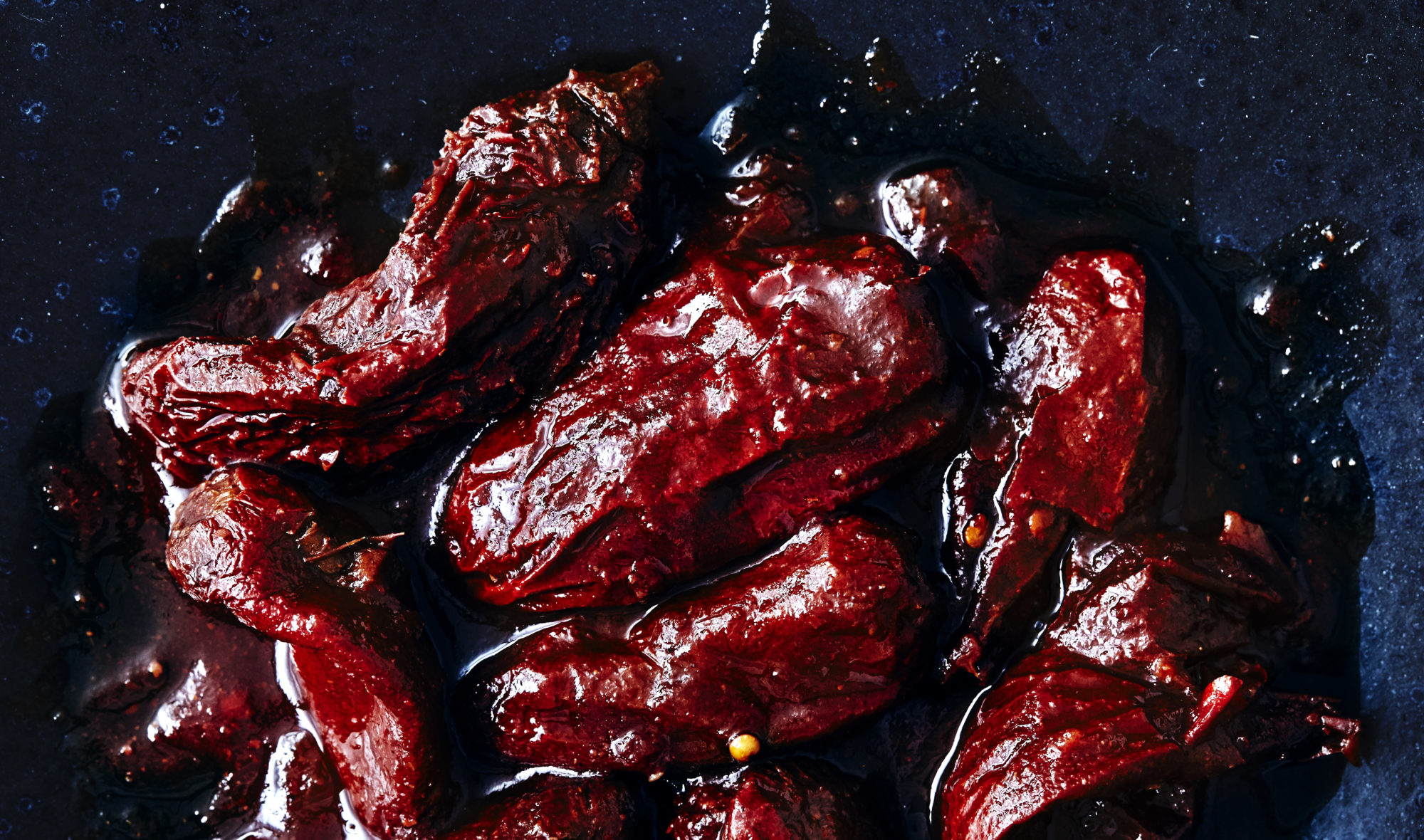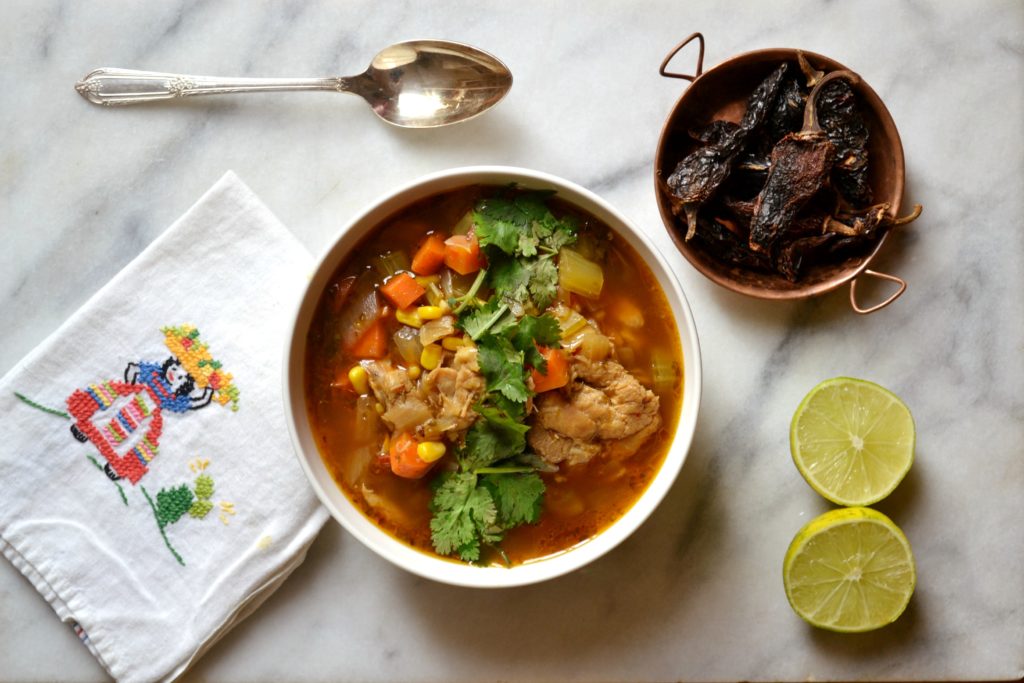Chipotle


Unbeknownst to many, chipotle pepper is not a specific type of pepper. Rather, chipotle is just a jalapeño pepper that has been smoked and dried to bring out a unique charred, spicy, and slightly fruity flavor. It was the ancient Aztecs of Mexico that began preparing jalapeños in this way; smoking the peppers allowed them to be preserved for long periods of time. Chipotle is still a prominent spice used in Mexican cuisine, and can be found in many recipes including salsa, meat marinades, and soups. Chipotle peppers are considered to have “medium” spiciness - slightly more spicy than a serrano pepper, and slightly less spicy than tabasco sauce. In other words, just spicy enough to make you sweat, but not enough to make you cry.
Chipotle, which is a word adapted from the Aztec term for “smoked chili”, is a jalapeño pepper that has been dried by smoke.
The Aztecs, ancient indigenous people of central Mexico, discovered that jalapeño peppers could be preserved with the aid of smoke. Normal sun-drying, another popular method of preservation, was not suited to the jalapeño, which would rot before it was fully dried.
Jalapeños can be green, red, purple, or tan, but in Chihuahua, the region of Mexico where most chipotle peppers come from, it is the morita jalapeño, an eggplant-colored pepper, that abounds. Chipotle can also be made from mature red jalapeños.
The smoking process takes a few days. Jalapeño peppers are placed on metal grills in smoking chambers or gas dryers, where they are shuffled around every couple of hours to ensure even smoking. Once this process is done, finished chipotle peppers will be shriveled and darkened, and possess the rich flavors of smoke and spice, with a hint of fruitiness.
Chipotle is a key ingredient in many traditional Mexican recipes, and is perhaps most famously used in a meat marinade called adobo. It is also the name of a popular Mexican chain restaurant where, depending on where you are in the world, you may or may not have to pay extra for guacamole on your burrito.
Chipotle may be found as dried whole peppers, or in powder form.
Dried whole chipotle peppers are purplish-red in color and look like shriveled up peppers (which they are). They are usually a few inches long and often still have their stems attached (which should be removed before eating).
Powdered chipotle is a deep brick-red.
Both forms have an intensely smoky, spicy, and slightly sweet flavor, but the whole dried peppers tend to be more punchy. As with most spices, flavors are better preserved when stored in the whole form.
Chipotle peppers are considered to have “medium” spiciness – slightly more spicy than a Serrano pepper, and slightly less spicy than Tabasco sauce.
Chipotle, in the amounts typically consumed, is not a significant source of any nutrients. It should be used primarily to provide bold flavor.
However, relative to its weight, chipotle is rich in a variety of carotenoids, which are compounds in the vitamin A family. It also contains a phytochemical called capsaicin, which may help to reduce inflammation in the body.
Chipotle may be found as whole dried peppers sealed in bags, or as a powder in glass jars, sachets, or loose in bulk bins.
However you choose to purchase it, shop at stores with a high turnover. Spices that stay on the shelves for long periods of time lose flavor and potency. As mentioned, for optimal flavor and a longer shelf life, try to find the whole dried peppers.
Good quality, fresh chipotle, whether whole or powdered, should have wonderfully smoky and pungent aroma, and a deep, warm red color. Fresh whole chipotle peppers will bend a bit before snapping. If they are very brittle, they may be old.
Chipotles may also be found in cans or jars with sauce (usually adobo) or oil, or in other spice blends. In these cases, read the ingredients label to ensure that high quality, whole food ingredients are used, and preservatives and dyes are avoided.
Chipotle, whether whole or powdered, should be stored in a sealed container at room temperature, ideally away from heat and light, such as a closed cupboard or drawer away from the oven.
Like most spices, chipotle won’t so much “go bad” as it will lose potency, which occurs after about six to eight months for the powder, and about a year for the whole peppers.
Powdered chipotle is ready to be used as-is, added to salsas or guacamole, sprinkled over cooked eggs, or rubbed onto chicken, pork, or white fish. It can also be added to stews or cooked beans.
Whole dried chipotle peppers require a bit of preparation before using.
In order to reconstitute dried chipotles so they can be chopped and mixed into recipes, boil some water, and then pour it into a large bowl. Place the chipotles in the bowl, ensuring that they are fully immersed, and let them sit for about 20 minutes. At this point, drain the water, and pat the chipotles dry. Cut the tough stems off, and then chop the softened peppers up so you can add them to salsas, marinades, soups, or other dishes.

Smoky and spicy chipotle peppers lace this chunky chicken soup with bold flavor and heat. Top with a sprinkle of cilantro for freshness and a squeeze of lime. Humble chicken soup is suddenly a culinary show-stopper.
Prep Time: 10 minutes Cook Time: 80 minutes Yield: 6-8 servings
Place 4 whole dried chipotle peppers in a bowl. Add a cup of boiled water to the bowl, and let sit for about 20-30 minutes.
Add olive oil to a large pot over medium high heat. Heat until a flick of water sizzles upon contact, then add the cumin seeds and the chicken.
Cook the chicken pieces on one side until they brown, about 5-7 minutes, and then flip the pieces and cook on the other side, about 5 minutes.
Add onions and garlic, and cook until they become soft, fragrant, and translucent, about 10 minutes. Add celery, carrots, and corn niblets, stir, and cook for another 5 minutes. Then, add the oregano and the broth, stir, and bring soup to a simmer.
In the meantime, return to your chipotle peppers that have been soaking in hot water for 20-30 minutes. Drain the water, and then chop the coarse stems off the peppers. Then, slice them in half lengthwise, and rinse out the seeds. Mince the peppers and add them to the soup.
Once you have added the chipotles, cover the pot with a lid and simmer the soup for an additional 60 minutes or so, or until chicken breaks apart easily with a spoon.
Allow soup to cool, and then add salt to taste. Upon serving, garnish bowls with a squeeze of fresh lime and a handful of of fresh chopped cilantro. If the soup is too spicy for your tastes, serve with a dollop of plain yogurt to cool the heat.
Precision Nutrition’s Encyclopedia of Food expands every single month as we highlight new foods and showcase beautiful food photography. If you’d like to stay up to date, simply click this link. From there, we’ll send you a FREE copy of our recipe book. We’ll also let you know when new and delicious foods are added to the site.
Unbeknownst to many, chipotle pepper is not a specific type of pepper. Rather, chipotle is just a jalapeño pepper that has been smoked and dried to bring out a unique charred, spicy, and slightly fruity flavor. It was the ancient Aztecs of Mexico that began preparing jalapeños in this way; smoking the peppers allowed them to be preserved for long periods of time. Chipotle is still a prominent spice used in Mexican cuisine, and can be found in many recipes including salsa, meat marinades, and soups. Chipotle peppers are considered to have “medium” spiciness - slightly more spicy than a serrano pepper, and slightly less spicy than tabasco sauce. In other words, just spicy enough to make you sweat, but not enough to make you cry.